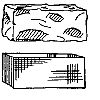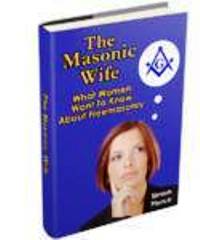Rough and Perfect Ashlar
 Rough and Perfect Ashlar
Rough and Perfect Ashlar
Rough and perfect ashlar stones symbolize Man's moral and spiritual life.
Cutting stone to uniform shapes and sizes requires the skill and experience of a true craftsman with many years of experience.
This is why, historically, only large edifices (buildings) were made of ashlars (rather than brick or wood), due to the necessity (and difficulty) of assembling the many skilled craftsman needed to complete the many subsets of knowledge such as:
- How to build a stone archway
- How to lay foundation stone
- And
how to lay stone, one atop another to great heights
- ...Not to mention the artisans who sculpted the stones into ornamental shapes.
In days of old, Apprentice masons cut and raised the Rough Ashlars from the stone quarry under the supervision of more experienced craftsman, called Fellowcrafts.
The work was accomplished under the watchful eye of the Master masons of the craft...those who had proved their ability to make their Master's piece to the satisfaction of their superiors.
In Freemasonry, there are 2 forms of ashlars.
Rough Ashlar
In operative Freemasonry, the rough ashlar represents a rough, unprepared or
undressed stone.
In speculative Freemasonry, a rough ashlar is an allegory to the uninitiated Freemason prior to his discovering enlightenment.
Perfect Ashlar
Operatively, the Perfect ashlar represents the dressed stone (after it has been made uniform and smoothed) by use of the working tools, the common gavel, (mallet) and chisel. (The chisel may be found in English Freemasonry, but is not used in the United States as a Freemason symbol.)
Only after the stone has been dressed by an experienced stonemason, can it be suitable to be placed into the architectural structure or building.
Speculatively, a Perfect Ashlar is an allegory to a Freemason who, through Masonic education, works to achieve an upstanding life and diligently strives to obtain enlightenment.
Rough and Perfect Ashlars
In the Fellowcraft Degree, we see the use of the Rough and Perfect Ashlars. The lesson to be learned is that by means of education and the acquirement of knowledge, a man improves the state of his spiritual and moral being.
Like man, each Rough Ashlar begins as an imperfect stone. With education, cultivation and brotherly love, man is shaped into a being which has been tried by the square of virtue and encircled by the compasses of his boundaries, given to us by our Creator.
Rough and Perfect Ashlar...Fitted For The Builder's Use
In ancient times, quarried stone which could be easily shaped into desired configurations, was called "freestone". Typical freestones are limestone and sandstone.
Then, as now, only after refining and smoothing these rough
stones into their desired shape, were the stonemasons able to "fit them for the
builder's use".
In the Fellowcraft degree, the Rough Ashlar represents a man's unrefined state
and his need for improvement. He learns that the goal of being a better
man includes spirituality of thought and striving for perfection of conduct.
Via duties, expectations and obligations, he is charged to work toward these goals of self improvement.
As the Freemason "smooths" his rough edges, internally and externally; he becomes a better man and, therefore, a better Freemason.
Once a man has perfected his ashlar to the best of his ability,... as
Brothers to all mankind, it is his duty to help others become better men and
better Freemasons.
Rough and Perfect Ashlar...The Potential For Change
All rough ashlars must have within them the potential to be made into a perfect ashlar.
The stone must be made of sound material and have a minimum of character flaws which may cause it to weaken the edifice (building). It must be capable of being worked into a perfect stone. This is why candidates for the degrees are asked many questions as to their qualifications and character about why they wish to become Freemasons.
The candidate must have the potential to both serve and support the Fraternity. He must be carefully inspected, just as each Rough Ashlar is inspected for quality in order to be able to "fit" him into Freemasonry's tenets and goals, which are compatible to God's laws.
An imperfect stone may be
made perfect, however major flaws are difficult to overcome and when assembled
into a structure, the entire structure can be weakened from its improper use.
This is as true of men as it is of stones.
Rough and Perfect Ashlar...States of Metamorphose
Freemasonry has a glorious history. Flawed ashlars can bring negative feelings and reproach upon the Fraternity from non-Freemasons in the outside world and therefore, can have no place within its walls.
...That said,...let us not forget that perfect ashlars are not found lying about the stone quarry without benefit of their having been hammered, chiseled and polished into such a state of being.
It also holds true that "perfect"
men are also such an anomaly without the benefit of brotherly love, guidance and
light. There are very few Freemasons who have not been in both the rough and
perfect ashlar state-of-being at some point in their lives.
Freemason Duties For the Future of the Craft
- Freemasons must give serious consideration to our personal
responsibility to educate other Brothers toward their self improvement.
- Like the Good Samaritan in the Holy Books; it is in the giving and assistance to others in which you will find the true "jewels" of enlightenment. True Master Masons not only exemplify the tenets of the craft, but they teach what they learn.
- Lodges should carefully judge the potential of each candidate,
weighing both their character and their potential for change. For more
information as to how to properly perform this duty, see my page
Masonic Investigation Committee.
- Each Freemason is charged to extend the hand of brotherly love and affection to help new Freemasons become better men and strive to live on the square, stand upright with the plumb and take their true place as a man who would make his Creator (the Almighty), proud of him.
The lesson of the Rough and Perfect Ashlar applies to all men who are worthy,...who have a heartfelt wish to go from ignorance to knowledge,...from darkness to light...and from death to life.
The following poem, written by Mary Brooks Picken, entitled, "Thimblefuls
of Friendliness" was written in 1924, and, perhaps says it, best.
"Thimblefuls of Friendliness"
"Isn't it strange that Princes and Kings
And clowns that caper in sawdust rings,
And just plain folks like you and me,
Are builders for Eternity?
To each is given a bag of tools,
A shapeless mass and a book of rules,
And each must make ere life is flown,
A stumbling block, or a stepping stone."
So,...it's up to you. What will YOU decide to build with YOUR working tools?
If you would like to Become a Freemason, all you have to do is ask.
To find a lodge near you, in the United States, go to my page of Masonic Lodge Locations.
To find a lodge near you, internationally, go to World Grand Lodges and follow the directions on the page.
Related Pages:
5 Fast Methods To Find the Information You Want to Learn About
- Search Box - Use the Search Box at the top of your page.
- Site Map - Use my Site Map page to find the topics you are most interested in.
- Carousel - Use the carousel of pages at the top of your screen.
- Menu Icon - On MOBILE, click the MENU button at the top of each page.
- Masonic Books - Browse through a selection of Masonic books.






